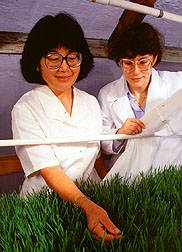Compression Puts the Squeeze on Hay Pests
|
|
Tightly compressed bales of freshly harvested hay destined for dairy cows, beef cattle, or racehorses in Japan can now move swiftly through agricultural inspections there, thanks to studies by Agricultural Research Service scientists. U.S. growers export about $240 million worth of hay to Japan every year.
Tests conducted for the past 6 years by entomologist Victoria Y. Yokoyama with ARS at Fresno, California, showed that compressing standard bales, then fumigating them with hydrogen phosphide for 7 days at 68oF, kills any Hessian flies that might be hiding inside.
Japan has recently approved this safe, practical quarantine procedure, ensuring that Hessian fly can't sneak into the country in baled hay. The new procedure applies to compressed bales of American-grown timothy, alfalfa, oat, bermudagrass, and sudangrass.
In the past, any unfumigated compressed bales with even a wisp of wheat--a Hessian fly favorite--or perhaps a stray stem of a weed species known to harbor the fly--would be rejected by Japanese agricultural inspectors to safeguard Japan's farms from this pest. Inspectors could send back--at the American shipper's expense--the entire container load.
Hessian fly is one of the worst insect enemies of wheat. It's believed the pesky insect hitchhiked to North America during the Revolutionary War, traveling inside straw mattresses used by Hessian mercenaries.
Yokoyama's tests with West Coast hay were the first to show that merely compressing the bales at 1,136 pounds of pressure per square inch killed a large proportion of the test insects concealed within the bales. For her experiments, Yokoyama and colleagues reared more than 630,000 Hessian flies. She did the work with Gina T. Miller and Preston L. Hartsell (now retired) at Fresno and Jim H. Hatchett, an ARS entomologist at Manhattan, Kansas.
Hydrogen phosphide fumigation provides an extra measure of pest control. The fumigation takes place inside cargo containers, after which American agricultural inspectors affix a sticker indicating that the containers' contents have been properly treated. Compressed bales shipped in containers that don't bear this "phytosanitary" certification are subject to time-consuming dockside inspections in Japan and run a high risk of rejection.
The idea of fumigating bales to rid them of insect stowaways is not new. Work at Manhattan by Hatchett and Charles L. Storey (now retired), for example, won Japan's approval in 1978 for phosphine fumigation of standard-size timothy hay bales. But Yokoyama's tests are the first to provide the extensive documentation needed to garner Japan's okay of a combined compression and fumigation technique for the increasingly popular compressed bales.
Only one-third the size of conventional bales, compressed bales are neat, compact, and easier to handle. They save storage and shipping costs because more of them can be squeezed into a barn, warehouse, or shipping container.
The National Hay Association, California Department of Food and Agriculture, and the Organization of Kittitas County Timothy Hay Growers and Shippers in Washington helped fund Yokoyama's research. — By Marcia Wood, Agricultural Research Service Information Staff, 800 Buchanan St., Albany, CA 94710; phone (510) 559-6070.
Victoria Y. Yokoyama is in the USDA-ARS Commodity Protection and Quarantine Insect Research Unit, Horticultural Crops Research Laboratory, 2021 S. Peach Ave., Fresno, CA 93727; phone (209) 453-3026, fax (209) 453-3126.
Compression Puts the Squeeze on Hay Pests " was published in the March 1998 issue of Agricultural Research magazine. Click here to see this issue's table of contents.







